
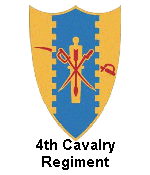
4th Cavalry Regiment
Organizational Legacy
"Prepared and Loyal"


|
|---|
| 4th US Cavalry Regiment In Formation at Fort Mead, SD - 17 July 1909 |
|---|

Regimental Distinctive Unit Insignia
 Introduction
Introduction


 The 1st Cavalry Division, a major subordinate command of the US Third Mobile
Armored Corps, is a 19,000 soldier, heavy armored division stationed at Ft.
Hood, TX. As one of the two "on-call" heavy contingency force divisions of the
Army, the First Team has an on-order mission to deploy by sea, air or land to
any part of the world on a short notice. The following narratives, divided in
timeline eras of major operational missions, describes the threat environment,
tactical conditions, evolution of equipment technology and the strategic
methodology employed by one of its subordinate units, the 4th Cavalry
Regiment, to contribute to the successful missions and enhancement of the
warring organization of the 1st Cavalry Division.
The 1st Cavalry Division, a major subordinate command of the US Third Mobile
Armored Corps, is a 19,000 soldier, heavy armored division stationed at Ft.
Hood, TX. As one of the two "on-call" heavy contingency force divisions of the
Army, the First Team has an on-order mission to deploy by sea, air or land to
any part of the world on a short notice. The following narratives, divided in
timeline eras of major operational missions, describes the threat environment,
tactical conditions, evolution of equipment technology and the strategic
methodology employed by one of its subordinate units, the 4th Cavalry
Regiment, to contribute to the successful missions and enhancement of the
warring organization of the 1st Cavalry Division.
 The early history of the organic units assigned to the 1st Cavalry Division
was closely tied to the movement of people and trade along the Oregon and
Santa Fe Trails. These routes, a result of perceived "manifest destiny",
extended the western domain of the United States into the far reaches of a
largely unsettled territory. More and more wagon trains, loaded with settlers,
rolling west were being attacked by Indians.
The early history of the organic units assigned to the 1st Cavalry Division
was closely tied to the movement of people and trade along the Oregon and
Santa Fe Trails. These routes, a result of perceived "manifest destiny",
extended the western domain of the United States into the far reaches of a
largely unsettled territory. More and more wagon trains, loaded with settlers,
rolling west were being attacked by Indians.
 By the 1830's it had become apparent that the rapidly expanding frontier
demanded highly mobile troops capable of covering the vast unpopulated areas
of the rugged terrain of the west, tracking down and pursue the Indians beyond
their usual haunts. The roots of the 1st Cavalry Division are found in an
answer to those who advocated a mounted military force for speed and mobility,
yet trained and properly equipped to fight dismounted as well as mounted. In
02 March 1833, the First US Regiment of Dragoons was constituted in the
Regular Army and subsequently on 04 March, the Regiment was organized at
Jefferson Barracks, Missouri.
By the 1830's it had become apparent that the rapidly expanding frontier
demanded highly mobile troops capable of covering the vast unpopulated areas
of the rugged terrain of the west, tracking down and pursue the Indians beyond
their usual haunts. The roots of the 1st Cavalry Division are found in an
answer to those who advocated a mounted military force for speed and mobility,
yet trained and properly equipped to fight dismounted as well as mounted. In
02 March 1833, the First US Regiment of Dragoons was constituted in the
Regular Army and subsequently on 04 March, the Regiment was organized at
Jefferson Barracks, Missouri.
 At the end of the Mexican War in 1848, the US Army had only three mounted
regiments, the 1st Dragoons, the 2nd Dragoons, and the Regiment of Mounted
Rifleman to protect settlers moving westward. In 1855, Congress, realizing the
number of mounted Soldiers was not enough, authorized the raising of two more
regiments, the 1st Cavalry and the 2nd Cavalry. The 1st Cavalry Regiment
(later redesignated as the 4th Cavalry Regiment on 03 August, 1861) was
constituted on 03 March 1855 and organized at Jefferson Barracks, Missouri on
26 March 1855 under the command of Colonel Edwin Voss Sumner. Upon completion
of the organization of the regiment in August 1855, the 1st (now the 4th)
Cavalry was assigned to Fort Leavenworth, Kansas. Its mission was two-fold; to
maintain law and order in the Kansas Territory between pro and anti-slavery
factions and to protect the settlers from attacks by the Cheyenne Indians. It
later became one of the most effective units of the Army against Indians on
the Texas frontier.
At the end of the Mexican War in 1848, the US Army had only three mounted
regiments, the 1st Dragoons, the 2nd Dragoons, and the Regiment of Mounted
Rifleman to protect settlers moving westward. In 1855, Congress, realizing the
number of mounted Soldiers was not enough, authorized the raising of two more
regiments, the 1st Cavalry and the 2nd Cavalry. The 1st Cavalry Regiment
(later redesignated as the 4th Cavalry Regiment on 03 August, 1861) was
constituted on 03 March 1855 and organized at Jefferson Barracks, Missouri on
26 March 1855 under the command of Colonel Edwin Voss Sumner. Upon completion
of the organization of the regiment in August 1855, the 1st (now the 4th)
Cavalry was assigned to Fort Leavenworth, Kansas. Its mission was two-fold; to
maintain law and order in the Kansas Territory between pro and anti-slavery
factions and to protect the settlers from attacks by the Cheyenne Indians. It
later became one of the most effective units of the Army against Indians on
the Texas frontier.
 The military aptitude of the original twenty-eight officers selected for the
1st (now the 4th) Cavalry was conclusively proven as the Civil War split many
of their allegiances, when twenty-two of them became general officers in
either the Union or Confederate armies. Among them were Captain George B.
McClellan, (Major General, Commander, Army of the Potomac and the inventor of
the famed McClellan saddle), and 2nd Lieutenant James E.B. (Jeb) Stuart,
(Major General, CSA, Commander of the Confederate Cavalry Corps). Later, in
1961, when Colonel Robert E. Lee assumed command of the 1st (now the 4th)
Cavalry he had to resign his commission a month later to lead the Confederate
States Army in the Civil War.
The military aptitude of the original twenty-eight officers selected for the
1st (now the 4th) Cavalry was conclusively proven as the Civil War split many
of their allegiances, when twenty-two of them became general officers in
either the Union or Confederate armies. Among them were Captain George B.
McClellan, (Major General, Commander, Army of the Potomac and the inventor of
the famed McClellan saddle), and 2nd Lieutenant James E.B. (Jeb) Stuart,
(Major General, CSA, Commander of the Confederate Cavalry Corps). Later, in
1961, when Colonel Robert E. Lee assumed command of the 1st (now the 4th)
Cavalry he had to resign his commission a month later to lead the Confederate
States Army in the Civil War.
 In 1866, soon after the end of the Civil war, Congress initiated additional
legislature to expand the number of cavalry regiments. The sound of the bugle
and the cry of "Charge" sent the thundering hooves of the US Cavalry troopers,
many who had former service in the Civil War, to oversee and protect the
western bound settlers in an era when Indians roamed the western frontier and
pioneering settlers clung to their land with determination. The 1st, 4th, 5th,
7th, 8th and 10th Cavalry Regiments (all eventually subordinate maneuvering
units of the 1st Cavalry Division) clashed with the Sioux, Comanche, Arapaho,
Apache and the Indian Nations during the Indian Wars.
In 1866, soon after the end of the Civil war, Congress initiated additional
legislature to expand the number of cavalry regiments. The sound of the bugle
and the cry of "Charge" sent the thundering hooves of the US Cavalry troopers,
many who had former service in the Civil War, to oversee and protect the
western bound settlers in an era when Indians roamed the western frontier and
pioneering settlers clung to their land with determination. The 1st, 4th, 5th,
7th, 8th and 10th Cavalry Regiments (all eventually subordinate maneuvering
units of the 1st Cavalry Division) clashed with the Sioux, Comanche, Arapaho,
Apache and the Indian Nations during the Indian Wars.
 On 22 January 1921 the 1st Cavalry Division was constituted in the US Regular
Army. On 13 September 1921, with the initiation of the National Defense Act,
the 1st Cavalry Division was formally activated at Ft. Bliss, TX and Major
General Robert Lee Howze, a Texas native from Rusk County and seasoned veteran
of then Frontier Indian Wars, Spanish American War, Philippines Insurrection,
Mexican Expedition, World War I and recipient of the Medal of Honor, was
selected as its first Division Commander.
On 22 January 1921 the 1st Cavalry Division was constituted in the US Regular
Army. On 13 September 1921, with the initiation of the National Defense Act,
the 1st Cavalry Division was formally activated at Ft. Bliss, TX and Major
General Robert Lee Howze, a Texas native from Rusk County and seasoned veteran
of then Frontier Indian Wars, Spanish American War, Philippines Insurrection,
Mexican Expedition, World War I and recipient of the Medal of Honor, was
selected as its first Division Commander.
 It was not until 15 October, 1957, when the 4th Cavalry Regiment joined with
the 1st Cavalry Division as the 2nd Battle Group, 4th Cavalry, (an element) of
the Pentomic Division in ceremonies held in Tonggu, Korea when the colors of
the 24th Infantry Division were retired and replaced by those of the 1st
Cavalry Division. The mission, at that time, was to support and help defend
Korea against the aggression of the Communist Doctrine that was spreading
throughout the Peninsula of Korea.
It was not until 15 October, 1957, when the 4th Cavalry Regiment joined with
the 1st Cavalry Division as the 2nd Battle Group, 4th Cavalry, (an element) of
the Pentomic Division in ceremonies held in Tonggu, Korea when the colors of
the 24th Infantry Division were retired and replaced by those of the 1st
Cavalry Division. The mission, at that time, was to support and help defend
Korea against the aggression of the Communist Doctrine that was spreading
throughout the Peninsula of Korea.
 As of today, the 4th Cavalry Regiment is currently represented by the
following active Units:
As of today, the 4th Cavalry Regiment is currently represented by the
following active Units:
- 1st Squadron, 4th Cavalry Regiment assigned to the 4th Heavy
Brigade Combat Team, 1st Infantry Division stationed at Fort
Riley, Kansas.
- 3rd Squadron, 4th Cavalry Regiment assigned to the 3rd Brigade
Combat Team, 25th Infantry Division - stationed at Schofield
Barracks, Hawaii.
- 4th Squadron, 4th Cavalry Regiment assigned to the 1st Heavy
Brigade Combat Team, 1st Infantry Division stationed at Fort
Riley, Kansas.
- 5th Squadron, 4th Cavalry Regiment assigned to the 2nd Heavy
Brigade Combat Team, 1st Infantry Division stationed at Fort
Riley, Kansas.
- 6th Squadron, 4th Cavalry Regiment assigned to the 3rd Brigade
Combat Team, 1st Infantry Division stationed at Fort Knox,
Kentucky.
 The above listing of 4th Cavalry Regiment active units
and their brigade assignments is at its best - may be inaccurate. Visitor
submissions of updated linage data is encouraged.
The above listing of 4th Cavalry Regiment active units
and their brigade assignments is at its best - may be inaccurate. Visitor
submissions of updated linage data is encouraged.

 This folio of material highlights of the many subsequent historical critical
missions performed by members of the 4th Cavalry Regiment, whose actions,
operations and the many critical issues resolved over its 154 year history to
meet the changing threat and the honors they achieved are summarized in the
following sections:
This folio of material highlights of the many subsequent historical critical
missions performed by members of the 4th Cavalry Regiment, whose actions,
operations and the many critical issues resolved over its 154 year history to
meet the changing threat and the honors they achieved are summarized in the
following sections:
 Table of Contents
Table of Contents


























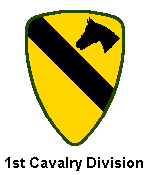



 If none of the data that you have found by surfing the reference unit chapter
titles and indexes measures up to your interests, you may want to deploy the
R&S (Reconnaissance and Surveillance) Scouts to search and identify keywords
or subjects within individual unit pages. Enter the descriptive keyword or
search terms(s) in the input field and "Click" on the Search button to screen the multiple DataBases of
the Cavalry OutPost and the garrisoned occupants - "The 1st Cavalry Division
and its Subordinate Units".
If none of the data that you have found by surfing the reference unit chapter
titles and indexes measures up to your interests, you may want to deploy the
R&S (Reconnaissance and Surveillance) Scouts to search and identify keywords
or subjects within individual unit pages. Enter the descriptive keyword or
search terms(s) in the input field and "Click" on the Search button to screen the multiple DataBases of
the Cavalry OutPost and the garrisoned occupants - "The 1st Cavalry Division
and its Subordinate Units".
 The search action will open the "first-team.us WebSite - R&S Scout Report",
which displays a listing of WebSite Titles and HTML Summaries that contain the
specific search term(s) of interest. To review any that best depicts a match
of your search term(s), "Click" on the WebSite Title to open a New Window.
After the WebSite is fully loaded, use the browser [EDIT/Find] Tool Button to
locate the search term within the page. After reviewing, close the New Window
to return to the listing of WebSites.
The search action will open the "first-team.us WebSite - R&S Scout Report",
which displays a listing of WebSite Titles and HTML Summaries that contain the
specific search term(s) of interest. To review any that best depicts a match
of your search term(s), "Click" on the WebSite Title to open a New Window.
After the WebSite is fully loaded, use the browser [EDIT/Find] Tool Button to
locate the search term within the page. After reviewing, close the New Window
to return to the listing of WebSites.
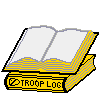



 If this is your first review of the Outpost of the 1st Cavalry Division and
its Subordinate Units, you may want to record your own report on your findings
during your visit, or perhaps you may want to review the log entries of other
visitors.
If this is your first review of the Outpost of the 1st Cavalry Division and
its Subordinate Units, you may want to record your own report on your findings
during your visit, or perhaps you may want to review the log entries of other
visitors.

To report on your findings,
"click" on the "Report-In"
Index Tab of the Troop Log. |
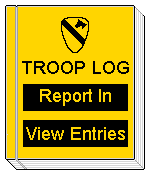
|

To review entries of others,
"Click"on the "View Entries"
Index Tab of the Troop Log. |
|---|

 As you journey through the history of the 1st Cavalry Division and its
assigned elements, you may find it interesting enough to send a message to
your friends and extend them an invitation for the opportunity to review the
rich history of the Division. We have made it easy for you to do. All that is
required is for you to click on the Push Button below, fill in their eMail
addresses and send.
As you journey through the history of the 1st Cavalry Division and its
assigned elements, you may find it interesting enough to send a message to
your friends and extend them an invitation for the opportunity to review the
rich history of the Division. We have made it easy for you to do. All that is
required is for you to click on the Push Button below, fill in their eMail
addresses and send.


|
The TITLE and URL of this WebSite are automatically read, formatted
and entered into your standard eMail form. |
|
|
Note - The eMail Message is processed and transmitted On-Line to the
addressee(s) via your Internet Provider.
Copyright © 2002, Cavalry Outpost Publications ® |




 eMail Your WebSite Comments.
eMail Your WebSite Comments.


 Return to "MyOwnPages"©.
Return to "MyOwnPages"©.

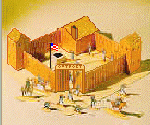 Copyright © 1996, Cavalry Outpost Publications ® and
Trooper Wm. H. Boudreau, "F" Troop, 8th Cavalry Regiment (1946 - 1947). All
rights to this body of work are reserved and are not in the public domain, or
as noted in the bibliography. Reproduction, or transfer by electronic means,
of the History of the 1st Cavalry Division, the subordinate units or any
internal element, is not permitted without prior authorization. Readers are
encouraged to link to any of the pages of this Web site, provided that proper
acknowledgment attributing to the source of the data is made. The information
or content of the material contained herein is subject to change without
notice.
Copyright © 1996, Cavalry Outpost Publications ® and
Trooper Wm. H. Boudreau, "F" Troop, 8th Cavalry Regiment (1946 - 1947). All
rights to this body of work are reserved and are not in the public domain, or
as noted in the bibliography. Reproduction, or transfer by electronic means,
of the History of the 1st Cavalry Division, the subordinate units or any
internal element, is not permitted without prior authorization. Readers are
encouraged to link to any of the pages of this Web site, provided that proper
acknowledgment attributing to the source of the data is made. The information
or content of the material contained herein is subject to change without
notice.
Revised 05 Apr '12 SpellChecked





 Introduction
Introduction















 Copyright © 1996, Cavalry Outpost Publications ® and
Trooper Wm. H. Boudreau, "F" Troop, 8th Cavalry Regiment (1946 - 1947). All
rights to this body of work are reserved and are not in the public domain, or
as noted in the bibliography. Reproduction, or transfer by electronic means,
of the History of the 1st Cavalry Division, the subordinate units or any
internal element, is not permitted without prior authorization. Readers are
encouraged to link to any of the pages of this Web site, provided that proper
acknowledgment attributing to the source of the data is made. The information
or content of the material contained herein is subject to change without
notice.
Copyright © 1996, Cavalry Outpost Publications ® and
Trooper Wm. H. Boudreau, "F" Troop, 8th Cavalry Regiment (1946 - 1947). All
rights to this body of work are reserved and are not in the public domain, or
as noted in the bibliography. Reproduction, or transfer by electronic means,
of the History of the 1st Cavalry Division, the subordinate units or any
internal element, is not permitted without prior authorization. Readers are
encouraged to link to any of the pages of this Web site, provided that proper
acknowledgment attributing to the source of the data is made. The information
or content of the material contained herein is subject to change without
notice.